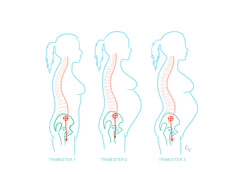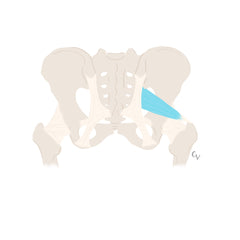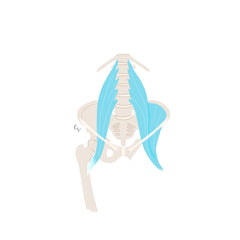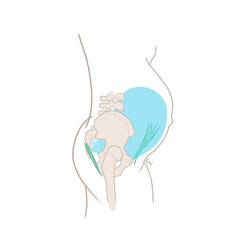Believe it or not, we aren't here to flip a breech baby. We're just here to help a woman's body do what it does best; to support her growing body and baby's growing body. As Webester Certified Chiropractors, we help with proper pelvic / sacral alignment and ligament tension as you progress through your pregnancy.

We do NOT flip a breech baby. We also do NOT tell women that their baby is breech.
Chiropractors are experts in the musculoskeletal system, we treat pain AND address how the body functions physically. When there is restrictions in the body [ joints, muscles, ligaments] we use safe and gentle high-velocity, low-amplitude [ HVLA ] manipulations to mobilize the joints. We also perform bodywork to release tension in the muscles and ligaments. When a woman has been told by her birth professional that her baby is breech [ because we don't do the telling ], we can work with the woman's pelvis to create the right amount of space for baby to move head down. Even when there is no pain, we're able to assess restriction in the pelvis. We work to reduce that restriction - because that could be preventing baby from moving head down.
Chiropractic care for breech babies is NOT invasive.
Because we focus on the musculoskeletal system, our treatments are never invasive. In other words, we're NOT touching baby or performing any procedures internally to flip your baby. We leave that to the birth professionals [ *more on ECVs below* ]. There isn't any undressing at any point during a patient's appointment. During Webster specifically, we are releasing tension and mobility in the pelvis, all while the patient is clothed.
Chiropractic care for breech babies is NOT SPINNING BABIES. So WHY chiropractic?
The adjusting component of chiropractic care offers a hands-on approach to mobilizing and creating proper alignment for the pelvis. This in turn supports the stretches and exercises a women does to encourage baby to go head down. It's more than a birth preparation plan. The chiropractor has the education and the tools [ proper table, pillows, and experience with their hands ] to effectively adjust [ create movement of ] the pelvic SI joints.
Webster technique is NOT about flipping a baby and ALL ABOUT pelvic mobility + proper positioning.
Women do NOT need to be breech for us to perform the Webster technique.
Webster technique is a pregnancy-specific chiropractic technique, it is not a breech baby technique. The Webster Technique certification is obtained through the ICPA, meaning chiropractors must attend the seminar and pass the written exam. The goal of the Webster technique is to reduce the effects of SI [ pelvis ] joint dysfunction. Reducing this dysfunction can help to decrease pain and optimize baby's positioning within the pelvic girdle.

Webster technique focuses on six specific areas of the pregnant woman's pelvis.
- the sacrum [ the triangle bone between the two bigger pelvic bones ]
- sacrotuberous ligament [ the ligament that goes from your "sits" bone to the tailbone ]
- piriformis [ the muscle that goes from your hip to your sacrum ]
- pubic bone [ "crotch bone" ]
- round ligament [ ligament over and to the side of the abdomen ]
- iliopsoas [ the hip flexor muscle ].
Tension in any of these areas can result in in-utero constraint. While the constraint is not physically visible, it may lead to baby feeling like there is less room to move in order to get head down for labor & delivery.



Webster is categorized as "right" and "left" which is determined by the side of sacral dysfunction. Based on our assessment, we know which side of each structure that needs to be worked on.
Patient does NOT need to have an ultrasound to recieve the Webster technique [ or any chiropractic care ] for breech babies.
As mentioned above, all pregnant patients are able to have the Webster technique performed if their chiropractor is certified. In our clinic, regardless of baby's positioning, we begin performing the Webster technique on all pregnant patients at 30 weeks. We will continue to do so until delivery - to optimize the natural physiology of each patient's pelvis. This means that an ultrasound is not required beforehand because we will assess using the Webster technique at every appointment.
Remember, the Webster technique is a pelvic balancing technique, not a breech baby technique. With balancing the sacral function [ again, that triangle bone between the two big pelvic bones ] and related structures, it is simply a tool we use to encourage baby to move head down. All pregnant patients benefit from pelvic balancing, as research as shown that chiropractic care decreases labor + delivery time by 25% [ or more with subsequent pregnancies ].
We LOVE to see women for chiropractic care twice before their 36 week ultrasound to help prevent baby from assuming a breech position.
When a woman finds out their baby is breech, it can be overwhelming. Unsure what that could mean for their birth plan or if there is anything to encourage baby to move head down.
For this reason, we incorporate the Webster technique into any pregnancy appointment where the woman is 30+ weeks along. We believe it is important to focus on balancing the pelvis at any point during the third trimester.
As with most conditions in the body, or life in general, a one-time visit rarely solves it all. With the lack of movement - mostly due to working from home or a computer - we encourage more movement for women. Ideally, we would see a woman at least twice before her 36 week ultrasound [ or the ultrasound that determines whether a patient will be scheduled for an ECV / c-section ] with her birth professional.
The more time we have to balance out tension, the better chance we have in getting baby out of the breech position. In the weeks leading up to the 36 week appointment [ or baby positioning appointment ], the pregnant mama will have time to do stretches and exercises at home [ we supply these tools for each and every one of our pregnant patient ].
There are reasons for a breech baby presentation - and the sacrum plays one of the biggest roles.
From Gail Tully : "In my experience, most babies are breech due to uterine ligaments and muscles being either too tight and asymmetrical (twisted or torqued) or too loose. This would be in the “imbalance” category. Imbalance can happen to anyone but can also be balanced with repetitions of balancing activities. Examples of imbalance are common enough but can contribute to a breech (or posterior) position:

The SACRUM is not straight. The short indent at the top of the buttocks veers a little towards one side.
The SACRUM may be rotated on a vertical axis.
There may be a buckle (small bulge) on the horizontal segments of the SACRUM.
The SI joints or the symphysis pubis may be out of alignment as well."
Because the SACRUM is part of the pelvis, adjusting the SACRUM / SI joints can make a world of difference with the misalignments / tension listed above.
Chiropractic care for breech babies is NOT the same as an ECV.
ECV stands for External Cephalic Version.
External cephalic version (EVC) is a procedure performed around 36 or 37 weeks gestation to turn a baby from a breech or side-lying (transverse) position to the optimal head-down position before labor.
MOVEMENT is one of the best ways to help baby assume a head down position.
Women these days are spending more time than ever behind a desk and at home. At home can mean more time working from a bed, couch or hightop at the counter. These positions can effect the alignment of the pelvis. Not to mention - working from home - typically means less movement throughout the day. And movement is most often a woman's best friend during pregnancy. So here's what we suggest :
+ set a timer for each hour to get up and move / walk for 1 minute
+ perform the stretches we have in any of our videos
+ stack specific exercises with something that you love doing and that you do EVERY DAY - a form of Habit Stacking from the book Atomic Habits
+ keep the pregnancy / exercise ball in front of the TV or by the bed or in a place frequented throughout the day
+ sit on a ball in intervals to create more movement throughout the day
We PROVIDE patients with movements to help if they ARE BREECH.
Pelvic balancing is SO important! It is our goal to ensure a woman's pelvis in the optimal position for baby's positioning and labor + delivery. Make sure you check out our Labor + Delivery Prep Guide for more stretches and exercises your patients can do to prepare for the big day!


